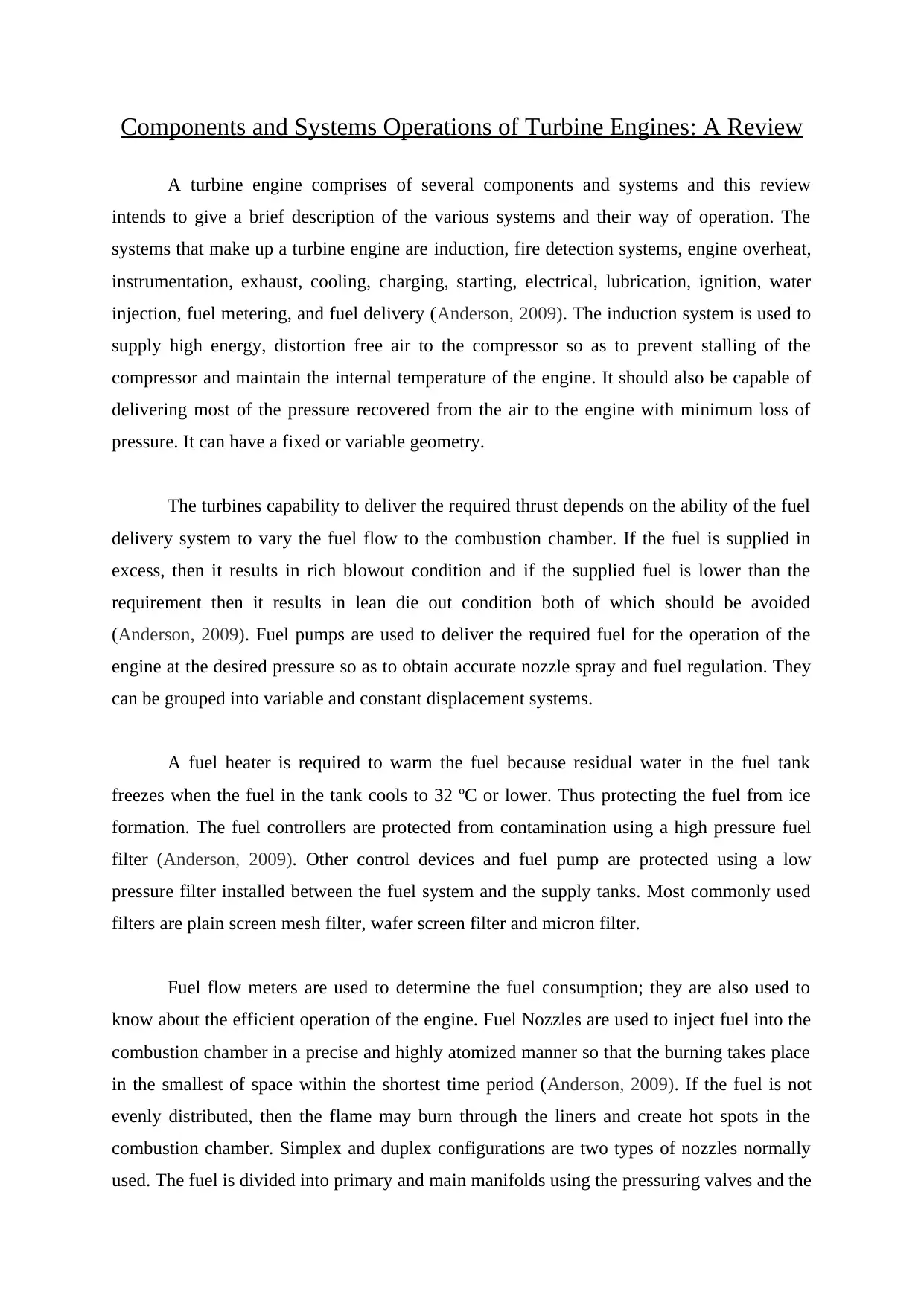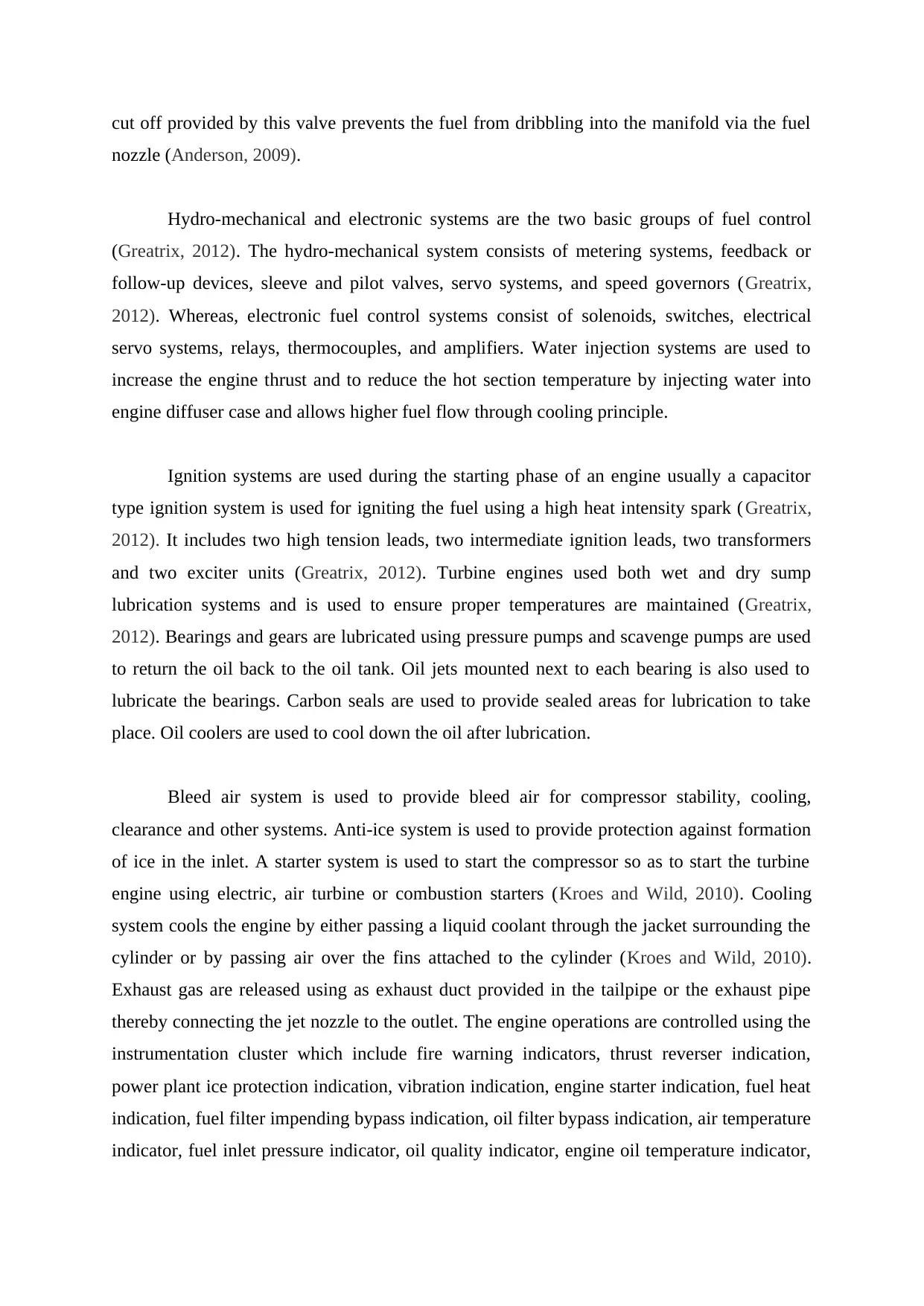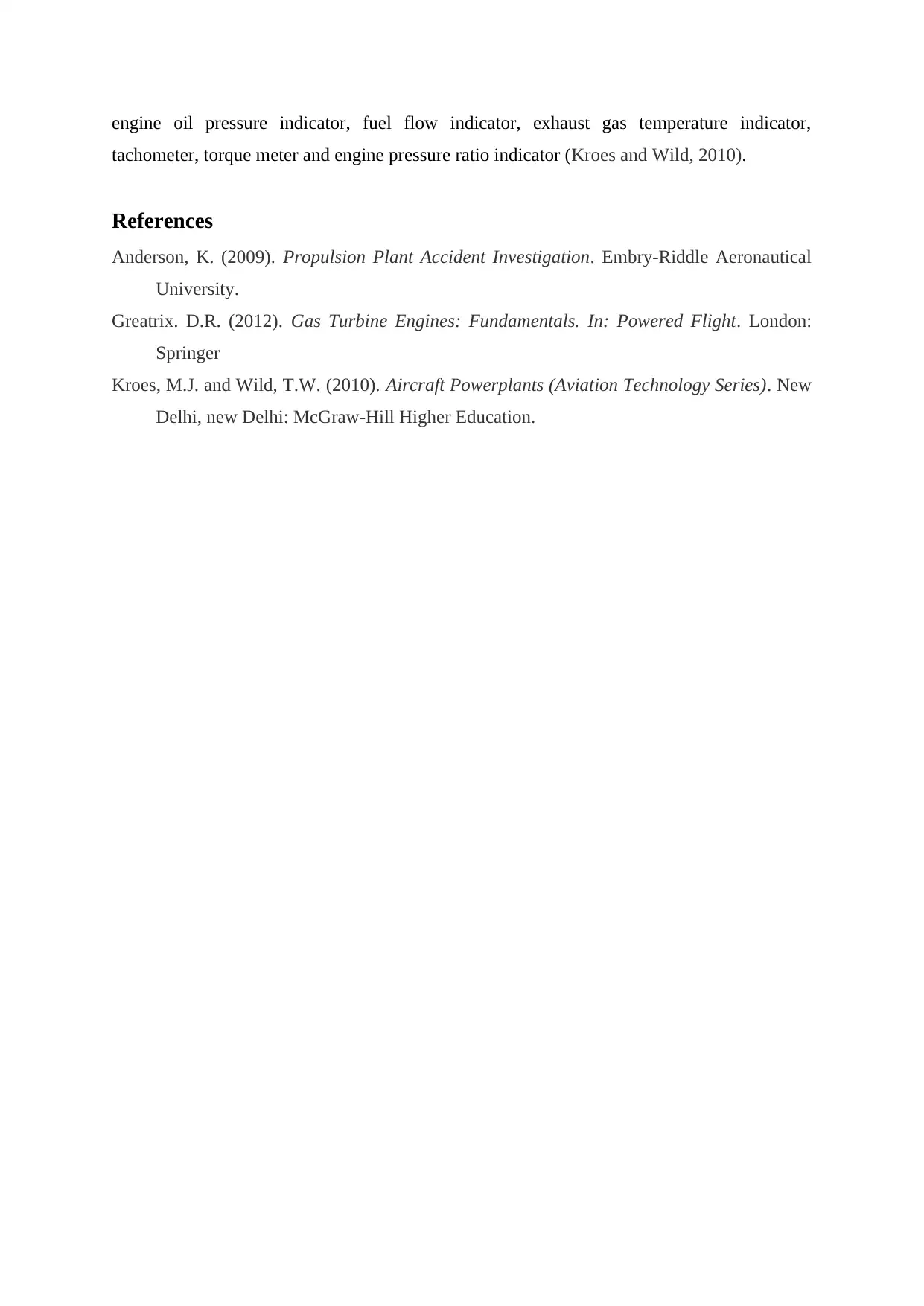Comprehensive Report: Turbine Engine Components and Systems
VerifiedAdded on 2019/11/08
|3
|1049
|283
Report
AI Summary
This report provides a comprehensive review of the components and systems that constitute a turbine engine. It details the function and operation of various systems including the induction system, fuel delivery system, ignition system, lubrication system, and exhaust system. The induction system is responsible for supplying high-energy air to the compressor, while the fuel delivery system manages fuel flow to the combustion chamber. The report explains the importance of fuel pumps, filters, and nozzles, as well as the hydro-mechanical and electronic systems that control fuel. It also covers the ignition system used during engine start-up, lubrication systems for maintaining proper temperatures, and cooling systems. Furthermore, the report touches upon the role of bleed air, anti-ice, and starter systems, as well as the instrumentation cluster used to monitor engine performance. The report references key texts by Anderson, Greatrix, and Kroes & Wild to support its findings.

Components and Systems Operations of Turbine Engines: A Review
A turbine engine comprises of several components and systems and this review
intends to give a brief description of the various systems and their way of operation. The
systems that make up a turbine engine are induction, fire detection systems, engine overheat,
instrumentation, exhaust, cooling, charging, starting, electrical, lubrication, ignition, water
injection, fuel metering, and fuel delivery (Anderson, 2009). The induction system is used to
supply high energy, distortion free air to the compressor so as to prevent stalling of the
compressor and maintain the internal temperature of the engine. It should also be capable of
delivering most of the pressure recovered from the air to the engine with minimum loss of
pressure. It can have a fixed or variable geometry.
The turbines capability to deliver the required thrust depends on the ability of the fuel
delivery system to vary the fuel flow to the combustion chamber. If the fuel is supplied in
excess, then it results in rich blowout condition and if the supplied fuel is lower than the
requirement then it results in lean die out condition both of which should be avoided
(Anderson, 2009). Fuel pumps are used to deliver the required fuel for the operation of the
engine at the desired pressure so as to obtain accurate nozzle spray and fuel regulation. They
can be grouped into variable and constant displacement systems.
A fuel heater is required to warm the fuel because residual water in the fuel tank
freezes when the fuel in the tank cools to 32 ºC or lower. Thus protecting the fuel from ice
formation. The fuel controllers are protected from contamination using a high pressure fuel
filter (Anderson, 2009). Other control devices and fuel pump are protected using a low
pressure filter installed between the fuel system and the supply tanks. Most commonly used
filters are plain screen mesh filter, wafer screen filter and micron filter.
Fuel flow meters are used to determine the fuel consumption; they are also used to
know about the efficient operation of the engine. Fuel Nozzles are used to inject fuel into the
combustion chamber in a precise and highly atomized manner so that the burning takes place
in the smallest of space within the shortest time period (Anderson, 2009). If the fuel is not
evenly distributed, then the flame may burn through the liners and create hot spots in the
combustion chamber. Simplex and duplex configurations are two types of nozzles normally
used. The fuel is divided into primary and main manifolds using the pressuring valves and the
A turbine engine comprises of several components and systems and this review
intends to give a brief description of the various systems and their way of operation. The
systems that make up a turbine engine are induction, fire detection systems, engine overheat,
instrumentation, exhaust, cooling, charging, starting, electrical, lubrication, ignition, water
injection, fuel metering, and fuel delivery (Anderson, 2009). The induction system is used to
supply high energy, distortion free air to the compressor so as to prevent stalling of the
compressor and maintain the internal temperature of the engine. It should also be capable of
delivering most of the pressure recovered from the air to the engine with minimum loss of
pressure. It can have a fixed or variable geometry.
The turbines capability to deliver the required thrust depends on the ability of the fuel
delivery system to vary the fuel flow to the combustion chamber. If the fuel is supplied in
excess, then it results in rich blowout condition and if the supplied fuel is lower than the
requirement then it results in lean die out condition both of which should be avoided
(Anderson, 2009). Fuel pumps are used to deliver the required fuel for the operation of the
engine at the desired pressure so as to obtain accurate nozzle spray and fuel regulation. They
can be grouped into variable and constant displacement systems.
A fuel heater is required to warm the fuel because residual water in the fuel tank
freezes when the fuel in the tank cools to 32 ºC or lower. Thus protecting the fuel from ice
formation. The fuel controllers are protected from contamination using a high pressure fuel
filter (Anderson, 2009). Other control devices and fuel pump are protected using a low
pressure filter installed between the fuel system and the supply tanks. Most commonly used
filters are plain screen mesh filter, wafer screen filter and micron filter.
Fuel flow meters are used to determine the fuel consumption; they are also used to
know about the efficient operation of the engine. Fuel Nozzles are used to inject fuel into the
combustion chamber in a precise and highly atomized manner so that the burning takes place
in the smallest of space within the shortest time period (Anderson, 2009). If the fuel is not
evenly distributed, then the flame may burn through the liners and create hot spots in the
combustion chamber. Simplex and duplex configurations are two types of nozzles normally
used. The fuel is divided into primary and main manifolds using the pressuring valves and the
Paraphrase This Document
Need a fresh take? Get an instant paraphrase of this document with our AI Paraphraser

cut off provided by this valve prevents the fuel from dribbling into the manifold via the fuel
nozzle (Anderson, 2009).
Hydro-mechanical and electronic systems are the two basic groups of fuel control
(Greatrix, 2012). The hydro-mechanical system consists of metering systems, feedback or
follow-up devices, sleeve and pilot valves, servo systems, and speed governors (Greatrix,
2012). Whereas, electronic fuel control systems consist of solenoids, switches, electrical
servo systems, relays, thermocouples, and amplifiers. Water injection systems are used to
increase the engine thrust and to reduce the hot section temperature by injecting water into
engine diffuser case and allows higher fuel flow through cooling principle.
Ignition systems are used during the starting phase of an engine usually a capacitor
type ignition system is used for igniting the fuel using a high heat intensity spark (Greatrix,
2012). It includes two high tension leads, two intermediate ignition leads, two transformers
and two exciter units (Greatrix, 2012). Turbine engines used both wet and dry sump
lubrication systems and is used to ensure proper temperatures are maintained (Greatrix,
2012). Bearings and gears are lubricated using pressure pumps and scavenge pumps are used
to return the oil back to the oil tank. Oil jets mounted next to each bearing is also used to
lubricate the bearings. Carbon seals are used to provide sealed areas for lubrication to take
place. Oil coolers are used to cool down the oil after lubrication.
Bleed air system is used to provide bleed air for compressor stability, cooling,
clearance and other systems. Anti-ice system is used to provide protection against formation
of ice in the inlet. A starter system is used to start the compressor so as to start the turbine
engine using electric, air turbine or combustion starters (Kroes and Wild, 2010). Cooling
system cools the engine by either passing a liquid coolant through the jacket surrounding the
cylinder or by passing air over the fins attached to the cylinder (Kroes and Wild, 2010).
Exhaust gas are released using as exhaust duct provided in the tailpipe or the exhaust pipe
thereby connecting the jet nozzle to the outlet. The engine operations are controlled using the
instrumentation cluster which include fire warning indicators, thrust reverser indication,
power plant ice protection indication, vibration indication, engine starter indication, fuel heat
indication, fuel filter impending bypass indication, oil filter bypass indication, air temperature
indicator, fuel inlet pressure indicator, oil quality indicator, engine oil temperature indicator,
nozzle (Anderson, 2009).
Hydro-mechanical and electronic systems are the two basic groups of fuel control
(Greatrix, 2012). The hydro-mechanical system consists of metering systems, feedback or
follow-up devices, sleeve and pilot valves, servo systems, and speed governors (Greatrix,
2012). Whereas, electronic fuel control systems consist of solenoids, switches, electrical
servo systems, relays, thermocouples, and amplifiers. Water injection systems are used to
increase the engine thrust and to reduce the hot section temperature by injecting water into
engine diffuser case and allows higher fuel flow through cooling principle.
Ignition systems are used during the starting phase of an engine usually a capacitor
type ignition system is used for igniting the fuel using a high heat intensity spark (Greatrix,
2012). It includes two high tension leads, two intermediate ignition leads, two transformers
and two exciter units (Greatrix, 2012). Turbine engines used both wet and dry sump
lubrication systems and is used to ensure proper temperatures are maintained (Greatrix,
2012). Bearings and gears are lubricated using pressure pumps and scavenge pumps are used
to return the oil back to the oil tank. Oil jets mounted next to each bearing is also used to
lubricate the bearings. Carbon seals are used to provide sealed areas for lubrication to take
place. Oil coolers are used to cool down the oil after lubrication.
Bleed air system is used to provide bleed air for compressor stability, cooling,
clearance and other systems. Anti-ice system is used to provide protection against formation
of ice in the inlet. A starter system is used to start the compressor so as to start the turbine
engine using electric, air turbine or combustion starters (Kroes and Wild, 2010). Cooling
system cools the engine by either passing a liquid coolant through the jacket surrounding the
cylinder or by passing air over the fins attached to the cylinder (Kroes and Wild, 2010).
Exhaust gas are released using as exhaust duct provided in the tailpipe or the exhaust pipe
thereby connecting the jet nozzle to the outlet. The engine operations are controlled using the
instrumentation cluster which include fire warning indicators, thrust reverser indication,
power plant ice protection indication, vibration indication, engine starter indication, fuel heat
indication, fuel filter impending bypass indication, oil filter bypass indication, air temperature
indicator, fuel inlet pressure indicator, oil quality indicator, engine oil temperature indicator,

engine oil pressure indicator, fuel flow indicator, exhaust gas temperature indicator,
tachometer, torque meter and engine pressure ratio indicator (Kroes and Wild, 2010).
References
Anderson, K. (2009). Propulsion Plant Accident Investigation. Embry-Riddle Aeronautical
University.
Greatrix. D.R. (2012). Gas Turbine Engines: Fundamentals. In: Powered Flight. London:
Springer
Kroes, M.J. and Wild, T.W. (2010). Aircraft Powerplants (Aviation Technology Series). New
Delhi, new Delhi: McGraw-Hill Higher Education.
tachometer, torque meter and engine pressure ratio indicator (Kroes and Wild, 2010).
References
Anderson, K. (2009). Propulsion Plant Accident Investigation. Embry-Riddle Aeronautical
University.
Greatrix. D.R. (2012). Gas Turbine Engines: Fundamentals. In: Powered Flight. London:
Springer
Kroes, M.J. and Wild, T.W. (2010). Aircraft Powerplants (Aviation Technology Series). New
Delhi, new Delhi: McGraw-Hill Higher Education.
⊘ This is a preview!⊘
Do you want full access?
Subscribe today to unlock all pages.

Trusted by 1+ million students worldwide
1 out of 3
Related Documents
Your All-in-One AI-Powered Toolkit for Academic Success.
+13062052269
info@desklib.com
Available 24*7 on WhatsApp / Email
![[object Object]](/_next/static/media/star-bottom.7253800d.svg)
Unlock your academic potential
Copyright © 2020–2025 A2Z Services. All Rights Reserved. Developed and managed by ZUCOL.



